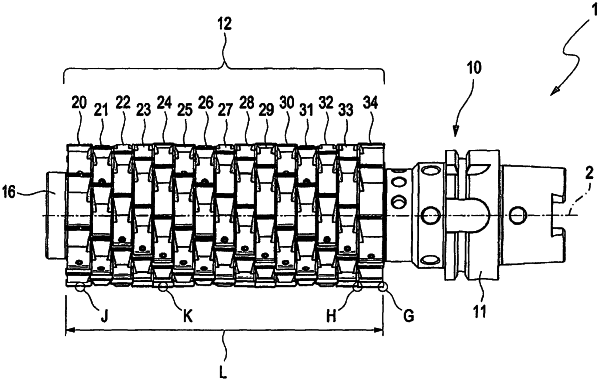| CPC B23C 3/34 (2013.01) [B23C 2210/244 (2013.01); B23C 2215/242 (2013.01); B23C 2220/36 (2013.01); B23C 2220/60 (2013.01)] | 20 Claims |

|
1. A roughening tool for roughening the cylindrical surface of a bore in a workpiece, by producing a defined microstructure that is composed of a plurality of microgrooves extending circumferentially at an axial distance from one another, comprising
a tool base body, which is capable of being driven so as to rotate about a rotational axis, and
a plurality of cutting tools, comprising at least a first cutting tool and a second cutting tool, each cutting tool is a discrete disk,
each cutting tool comprising a plurality of cutting elements, each cutting element comprising a plurality of cutting teeth that are arranged at an axial distance from one another, each cutting element of the first cutting tool having an identical cutting tooth profile, each cutting element of the first cutting tool having a first cutting tooth profile, each cutting element of the second cutting tool having a second cutting tooth profile, the first cutting tooth profile is different from the second cutting tooth profile, wherein each cutting element profile is the entirety of the cutting teeth in a plan view of a rake face of a respective cutting element of the plurality of cutting elements,
each cutting tool comprising a respective central recess through which the tool base body extends, an exterior of the tool base body and the central recess of the first cutting tool are shaped such that the first cutting tool is capable of being positioned in at least first and second rotational positions relative to the tool base body, the first rotational position differing from the second rotational position, wherein:
with the first cutting tool in the first rotational position, the tool base body would not prevent the first cutting tool from being slid along the rotational axis relative to the tool base body, and the tool base body prevents the first cutting tool from rotating about the rotational axis relative to the tool base body, and
with the first cutting tool in the second rotational position, the tool base body would not prevent the first cutting tool from being slid along the rotational axis relative to the tool base body, and the tool base body prevents the first cutting tool from rotating about the rotational axis relative to the tool base body.
|